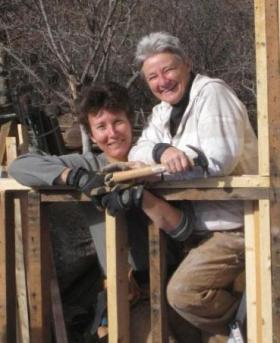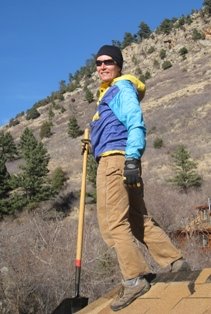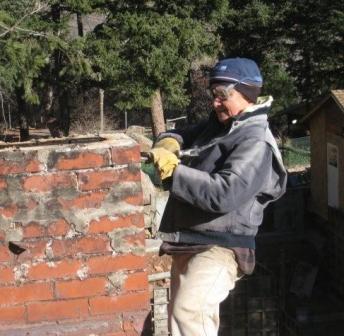 I am holding FatMax, our new laser level, on the sill plate above the west wall, aiming it at Rebecca as she leans over the east wall, watching her line up the red beam with a little piece of wood that is marking the edge of our soon-to-be-built weight-bearing wall. This is not just any weight-bearing wall- it is our first one. This is the wall that will hold our first joists, which will hold our first floor panels, which will hold our next level of exterior walls. This wall is the gateway to all future progress, and its anticipated arrival has receded further and further back on the timeline horizon, while we have impatiently slogged through the rainiest spring and early summer in decades, spent countless trips driving back and forth to Home Depot, and persevered through multiple unforeseen problems.
I am holding FatMax, our new laser level, on the sill plate above the west wall, aiming it at Rebecca as she leans over the east wall, watching her line up the red beam with a little piece of wood that is marking the edge of our soon-to-be-built weight-bearing wall. This is not just any weight-bearing wall- it is our first one. This is the wall that will hold our first joists, which will hold our first floor panels, which will hold our next level of exterior walls. This wall is the gateway to all future progress, and its anticipated arrival has receded further and further back on the timeline horizon, while we have impatiently slogged through the rainiest spring and early summer in decades, spent countless trips driving back and forth to Home Depot, and persevered through multiple unforeseen problems.Problems like the SIP panels that were cut wrong at the factory and knocked the south wall ¾” out of plumb. It was the manufacturers fault, and once we finally figured out what was wrong, they fixed it. That was easy- there was someone else to take the blame. But every other problem has sat squarely on our shoulders. Unlike the house, which has had nothing square about it. The south basement wall turned out to be half an inch too long, due to a last minute “Stop Production!” call to the SIP manufacturer, asking them to make the wall half an inch longer. It made sense at the time, but it was a bad mistake. It threw the whole building out of square, which meant two days of climbing up and down ladders to the tops of our four corners, endless measuring of lengths, widths, and diagonals, scribbling math on scraps of lumber and scratching our heads as we tried to remember our tenth grade geometry.
That’s when I got a black eye. Bad domestic dispute, you might wonder? Nope. Improper use of power tools? Nope. It was a tape measure accident- a flying metal tape whipping back into its housing in frustrated exasperation. They really should have a warning on that thing- it’s a dangerous tool.

We ended up sawing half an inch off of our too-long wall, and sawed off parts of our sill plates to get things square to within an eighth of an inch. We had many heated discussions about how miserable or happy our lives could be, living in a house with the knowledge that the bedroom corner was wandering off an eighth of an inch to the northeast. But in the end, that eighth inch was looking pretty good. It was better than the sip plates that were bowed out by ¾” in several spots. That required an elaborate rope and pulley z-drag system, thanks to my days of Outward Bound tyrolean traverses. We yanked the walls in and popped the top plates in to hold them, all done in between rain showers, dental appointments, and equally annoying tangential tasks. Next was leveling the sill plates that had become warped and uneven during the weeks of rain. But by now we had become more comfortable with those eighth inch discrepancies, and this only took a day of measuring and shimming.
And now, today, finally, it was time to build our first wall. I steadied FatMax’s little red beam and saw it show up on Rebecca’s measuring stick. “About a sixty fourth of an inch to the left!” she shouted. A sixty fourth??? You’ve got to be kidding. But our tolerance for each other has grown during this project. So I did not hurl Little Fatso across the house, nor did I point out the absurdity of sixty fourth inch measurements. I gave FatMax the tiniest tap I could muster. “Too far!” she yelled. So I tapped gently back and forth, while the clouds rolled by and June casually plodded along in the direction of July, until Max’s little red beam could not have been more perfectly aligned.
 Did we get the wall built? No. The bottom plate was uneven and we were out of shims, the power to the saw kept cutting off, and the grey day blessed us with a sequence of tiny rain showers. But we have learned to appreciate small steps. The boards are measured, labeled, and cut, and waiting under a tarp for tomorrow, when they will finally take their place in a straight and perfect wall. Or maybe the next day.
Did we get the wall built? No. The bottom plate was uneven and we were out of shims, the power to the saw kept cutting off, and the grey day blessed us with a sequence of tiny rain showers. But we have learned to appreciate small steps. The boards are measured, labeled, and cut, and waiting under a tarp for tomorrow, when they will finally take their place in a straight and perfect wall. Or maybe the next day.

We ended up sawing half an inch off of our too-long wall, and sawed off parts of our sill plates to get things square to within an eighth of an inch. We had many heated discussions about how miserable or happy our lives could be, living in a house with the knowledge that the bedroom corner was wandering off an eighth of an inch to the northeast. But in the end, that eighth inch was looking pretty good. It was better than the sip plates that were bowed out by ¾” in several spots. That required an elaborate rope and pulley z-drag system, thanks to my days of Outward Bound tyrolean traverses. We yanked the walls in and popped the top plates in to hold them, all done in between rain showers, dental appointments, and equally annoying tangential tasks. Next was leveling the sill plates that had become warped and uneven during the weeks of rain. But by now we had become more comfortable with those eighth inch discrepancies, and this only took a day of measuring and shimming.
And now, today, finally, it was time to build our first wall. I steadied FatMax’s little red beam and saw it show up on Rebecca’s measuring stick. “About a sixty fourth of an inch to the left!” she shouted. A sixty fourth??? You’ve got to be kidding. But our tolerance for each other has grown during this project. So I did not hurl Little Fatso across the house, nor did I point out the absurdity of sixty fourth inch measurements. I gave FatMax the tiniest tap I could muster. “Too far!” she yelled. So I tapped gently back and forth, while the clouds rolled by and June casually plodded along in the direction of July, until Max’s little red beam could not have been more perfectly aligned.
 Did we get the wall built? No. The bottom plate was uneven and we were out of shims, the power to the saw kept cutting off, and the grey day blessed us with a sequence of tiny rain showers. But we have learned to appreciate small steps. The boards are measured, labeled, and cut, and waiting under a tarp for tomorrow, when they will finally take their place in a straight and perfect wall. Or maybe the next day.
Did we get the wall built? No. The bottom plate was uneven and we were out of shims, the power to the saw kept cutting off, and the grey day blessed us with a sequence of tiny rain showers. But we have learned to appreciate small steps. The boards are measured, labeled, and cut, and waiting under a tarp for tomorrow, when they will finally take their place in a straight and perfect wall. Or maybe the next day.


















